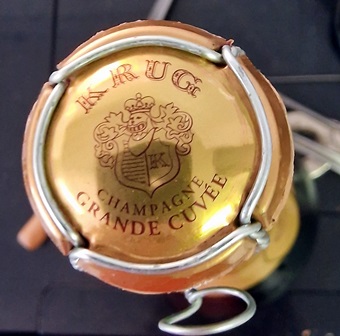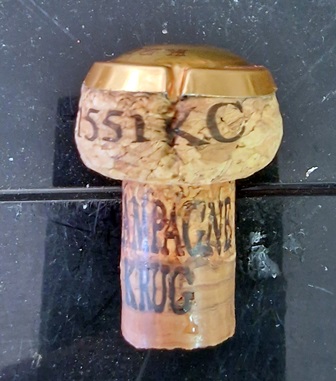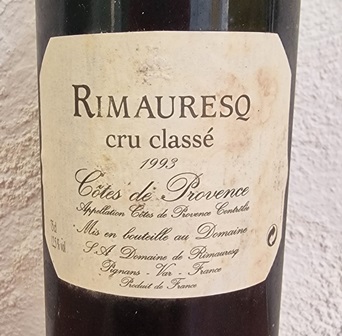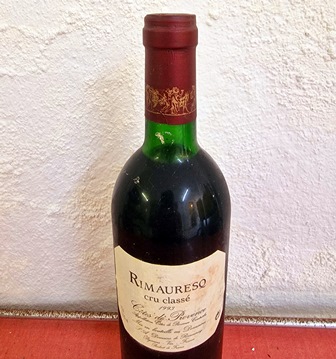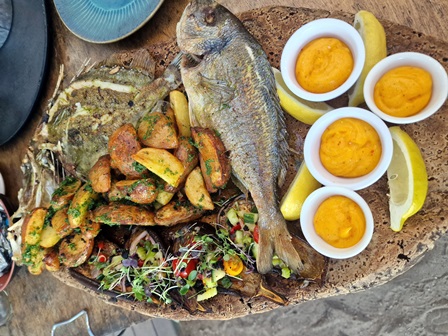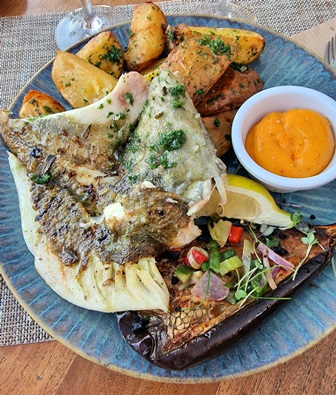J’ai mis de temps à autre sur Instagram des énigmes. Il y a quelques mois, la réponse à trouver était un nombre. Deux vainqueurs sont proclamés et peu après je me rends compte que j’ai fait une erreur de calcul. La réponse n’était pas la bonne. Je trouve d’autres gagnants. L’idée que les premiers gagnants soient tristes me déplait aussi cinq gagnants sont désignés.
La tradition est que j’invite les gagnants à un repas avec de belles bouteilles. Les dates possibles pour les cinq élus incluant la date de l’académie des vins anciens, je leur propose cette option et ils donnent tous les cinq leur accord pour participer à l’académie. Ils seront mes invités et à ma table.
L’académie des vins anciens tient sa 40ème édition au restaurant Macéo. Nous serons 37 participants avec de plus en plus d’étrangers. Nous sommes répartis en trois tables, la mienne ayant treize convives et les deux autres douze. Les cinq gagnants de l’énigme sont regroupés à côté de moi dont un de Los Angeles, un de Londres, un néerlandais et deux français. Les autres académiciens de ma table sont des habitués, sauf un espagnol enthousiaste et ma voisine de table, une américaine qui a participé à plus de 20 dîners.
Il y aura 54 vins, ce qui est beaucoup, car j’ai fourni 28 vins, voulant que toutes les tables aient un beau souvenir de le 40ème séance.
L’ouverture des vins commence à 15 heures. Un académicien fidèle m’aide ainsi que Béatrice, qui est la responsable du rangement de ma collection de bouteilles vides. Il y a énormément de bouchons qui sortent en miettes et je me demande toujours si les conditions atmosphériques ne jouent pas un rôle dans les comportements des bouchons, souvent semblables. Il y a parmi ces vins des niveaux assez bas, y compris dans mes apports, car chaque vin a le droit d’être bu, surtout en situation de pléthore comme aujourd’hui. Quelques vins sentent le bouchon, nous verrons. Globalement, il y a de très belles promesses.
Le menu composé par Adrian Williamson et son équipe est : sardine bretonne à l’huile d’olive, toast et fenouil croquant / médaillon de thon juste saisi, courgette et fleur de courgette farcie aux olives noires / épaule d’agneau confite aux herbes de Provence, carotte et navet glacés, jus corsé / trio de fromage et fourme d’Ambert / tarte fine aux pommes et crème d’Isigny.
L’apéritif est fait de : Côtes du Jura Château de Quintigny magnum sans année, Champagne Bollinger Spéciale Cuvée années 70, Champagne Laurent-Perrier sans année, Champagne Besserat de Bellefon sans année, Champagne Pommery années 80.
Les vins de table 1 sont : Champagne Mumm Cordon Rouge 1979, Hermitage blanc Poulet père et fils 1923 (niveau bas), Rioja blanc Mariano Lacort 1931, Montrachet Roland Thévenin 1947, Château Troplong Mondot Valette Saint-Emilion 1971, Château Palmer Margaux 1964, Château Lanessan 1985, Château Lynch Bages 1969, Vosne Romanée Antonin Rodet vers 1966, Echézeaux Mommessin 1973, Romanée Saint-Vivant Moillard Grivot 1937, Richebourg Théophile Gavin 1928, Vega Sicilia Unico 1962, Castell del Remey Extra Costers del Segre (Catalonia) # 1915, Gewurztraminer Clos Zisser Vendanges Tardives 1961, Château Pajot Enclave Yquem Sauternes 1965 , Cru de Coÿ Enclave Yquem 1923, Cognac Leyrat XO élite 40°.
Les vins de la table 2 sont : Meursault-Charmes P. Millot Battault 1969 , Chassagne Montrachet Henri Pillot 1959, Corton-Charlemagne J. d’Issoncourt 1990, Riesling Sylvaner Koenigschaffhauser , Kaiserstuhl 1970 , Château Haut Marbuzet 1967, Château Magdelaine Saint-Emilion J. P. Moueix 1964, Château Tour de Corbin Despagne Saint-Emilion 1975, Château Pichon Lalande Comtesse Pauillac 1967, Château Malescot St Exupéry Margaux 1971 , Château L’Angélus Pomerol (bas) 1964, Beaune Perrières rouge Guy Leblanc 1967, Aloxe Corton Joseph Drouhin 1969, Château Doisy-Daëne Barsac 1969, Château Sigalas Rabaud 1959, Château Cantegril Sauternes 1943.
Les vins de la table 3 sont : Champagne Pommery sans année, Meursault Calvet (bas) 1962, Riesling grand cru Côte de Barr Klipfel 1970, Château d’Agassac 1966, Château Larcis Ducasse Saint-Emilion 1964, Château Giscours 1964 , Château Cantemerle 1964, Château Haut Marbuzet 1967, Château Lascombes 1971, Mouton Cadet sélection Rothschild 1943, Côtes de Barr Riesling Grand Cru Louis Klipfel 1970, Vin Jaune Château l’Etoile 1981, Anjou Coteaux de la Loire négociants 1955, Château de Rolland Sauternes 1943, Château Coutet Barsac 1962, Rivesaltes Domaine Marie 1940.
A l’apéritif, nous commençons par un Côtes du Jura Château de Quintigny magnum sans année. Je croyais que c’était un vin blanc et je l’avais affecté à un groupe, mais en fait c’est un crémant du Jura que je fais servir en premier. On est loin des subtilités des champagnes, mais ce pétillant est bien agréable comme vin d’accueil.
Le Champagne Bollinger Spéciale Cuvée années 70 est remarquable car il est entré avec pertinence dans le monde des vins anciens. Il est noble et racé.
Le Champagne Laurent-Perrier sans année est plus conventionnel et le Champagne Besserat de Bellefon sans année est une très agréable surprise. Le Champagne Pommery années 80 est d’une belle personnalité, déjà paré des vertus des champagnes anciens.
J’ai bu les vins de la table 1. Le Champagne Mumm Cordon Rouge 1979 est agréable, mais il me fait mesurer à quel point il y a un écart entre le Cordon Rouge et le Mumm Cuvée René Lalou 1979, un vin de très haute qualité.
Adrian le directeur du restaurant fait le service des vins de notre table. Il me fait goûter en premier un peu de chaque vin pour que je puisse prévenir les convives. Et en sentant l’Hermitage blanc Poulet père et fils 1923 au niveau bas, je préviens mes amis qu’il ne faut pas s’arrêter au parfum vieux de ce vin. Et par un miracle comme il n’en arrive que dans les rêves, la sardine au goût très fort va effacer toute trace de vieillesse et l’Hermitage va briller, créant le plus bel accord du repas. Béatrice, qui était à une autre table, me fit remarquer que la sardine avait un goût qui rebutait les vins de sa table, alors qu’elle a ressuscité notre vin de 101 ans.
Le Rioja blanc Mariano Lacort 1931 associé au même plat est beaucoup trop monocorde, presque fade et n’apporte pas l’émotion qu’il offrirait peut-être en d’autres circonstances.
Le Montrachet Roland Thévenin 1947 est très conforme à ce que l’on pourrait attendre, très bien structuré. Ce n’est pas un montrachet puissant et séducteur, c’est un grand vin noble. C’est probablement le meilleur des Montrachets 1947 de ce négociant que j’aie déjà bus.
Le Château Troplong Mondot Valette Saint-Emilion 1971 est d’une année très grande pour les bordeaux de la rive droite. Et l’on apprécie sa grandeur et sa profondeur. On le ressent à un sommet de ce qu’il peut offrir. Il est grand.
J’avais choisi parmi mes apports un Château Palmer Margaux 1964 au niveau bas, voulant vérifier si ce vin solide tenait encore sa place à 60 ans. A ma grande joie il a gardé toute son énergie et cette densité si noble. C’est une belle surprise, mais évidemment pas un cas général.
J’avais inclus dans mon apport une bouteille illisible que je situais dans les années 70 mais en ouvrant la bouteille on pouvait lire sur le bouchon Château Lanessan 1985. Il est plus jeune que les autres et fort agréable.
Le Château Lynch Bages 1969 ne m’est pas apparu au niveau des autres car il a été apporté avec mon accord au moment du repas, car offert par un participant étranger qui ne pouvait pas l’envoyer de son pays. Il n’a pas eu l’aération qui convenait.
Après quatre bordeaux, quatre bourgognes. Le Vosne Romanée Antonin Rodet vers 1966 est un vin agréable et subtil.
L’Echézeaux Mommessin 1973 est une magnifique surprise pour moi. Tout-à-fait inattendu, il a une acidité très agréable, une grande subtilité et un goût que l’on n’attendrait pas de ce millésime. J’ai adoré.
Mais on oublie tout dès que le Romanée Saint-Vivant Moillard Grivot 1937 est servi. Le parfum est envoûtant, le vin est glorieux. C’est la Bourgogne dans ce qu’elle offre de mieux. Quel grand vin.
Je suis un admirateur des millésimes 1928 et 1929, millésimes du siècle, dont j’ai bu 424 vins de cette paire royale. Le Richebourg Théophile Gavin 1928 est un grand vin, mais force est de constater que le 1937 est beaucoup plus glorieux. Le Richebourg est grand mais ne peut pas offrir autant de complexités et de grandeur.
On peut faire la même remarque pour le Vega Sicilia Unico 1962 d’un grand millésime et de belle noblesse, mais qui n’est pas au niveau au niveau qu’il pourrait avoir. Il manque d’émotion.
Le jeune espagnol si enthousiaste qui m’avait aidé à ouvrir les vins a apporté un Castell del Remey Extra Costers del Segre (Catalonia) # 1915. L’année supposée lui avait été annoncée par celui qui lui avait vendu la bouteille mais rien ne peut justifier un tel millésime. Je le verrais volontiers de moins de cinquante ans. Il n’a pas pu accrocher mon intérêt.
Le Gewurztraminer Clos Zisser Vendanges Tardives 1961 est absolument superbe d’une fluidité parfaite. Elégant et agréable.
Un académicien ayant proposé un sauternes 1965 « enclave d’Yquem », j’ai choisi en cave un autre vin enclave d’Yquem de 1923. Le Château Pajot Enclave Yquem Sauternes 1965 est un beau sauternes, riche et joyeux. Mais le Cru de Coÿ Enclave Yquem 1923 est transcendantal. D’une grâce infinie.
L’un des gagnants de l’énigme a apporté un Cognac Leyrat XO élite 40° très élégant et fin qui a conclu notre repas.
L’ambiance du repas a été particulièrement chaleureuse. Les gagnants de l’énigme, qui ne se connaissaient pas, sont devenus des amis. Pour certains, ce fut la découverte d’un nouveau monde. Qui se serait intéressé à un vin de 1937 ? Mes nouveaux amis vont devenir plus attentifs.
Mon classement des vins que nous avons bus à ma table est : 1 – Cru de Coÿ Enclave Yquem 1923, 2 – Romanée Saint-Vivant Moillard Grivot 1937, 3 – Hermitage blanc Poulet père et fils 1923, 4 – Echézeaux Mommessin 1973, 5 – Gewurztraminer Clos Zisser Vendanges Tardives 1961, 6 – Vega Sicilia Unico 1962.
Le thon a bien joué son rôle sur les bordeaux et l’agneau sur les bourgognes. Mais l’accord transcendantal parce qu’imprévu est celui de la sardine sur l’Hermitage blanc, ce qui a permis à ce vin d’être aussi bien classé dans mon vote.
Voilà une quarantième séance de l’académie particulièrement réussie.


